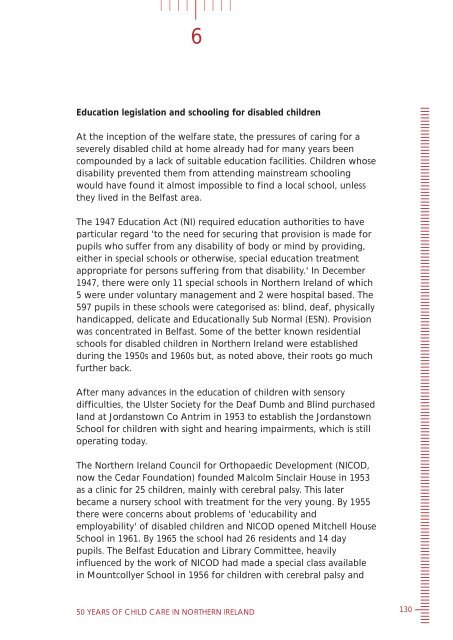childcare-50years
childcare-50years
childcare-50years
You also want an ePaper? Increase the reach of your titles
YUMPU automatically turns print PDFs into web optimized ePapers that Google loves.
6<br />
Education legislation and schooling for disabled children<br />
At the inception of the welfare state, the pressures of caring for a<br />
severely disabled child at home already had for many years been<br />
compounded by a lack of suitable education facilities. Children whose<br />
disability prevented them from attending mainstream schooling<br />
would have found it almost impossible to find a local school, unless<br />
they lived in the Belfast area.<br />
The 1947 Education Act (NI) required education authorities to have<br />
particular regard 'to the need for securing that provision is made for<br />
pupils who suffer from any disability of body or mind by providing,<br />
either in special schools or otherwise, special education treatment<br />
appropriate for persons suffering from that disability.' In December<br />
1947, there were only 11 special schools in Northern Ireland of which<br />
5 were under voluntary management and 2 were hospital based. The<br />
597 pupils in these schools were categorised as: blind, deaf, physically<br />
handicapped, delicate and Educationally Sub Normal (ESN). Provision<br />
was concentrated in Belfast. Some of the better known residential<br />
schools for disabled children in Northern Ireland were established<br />
during the 1950s and 1960s but, as noted above, their roots go much<br />
further back.<br />
After many advances in the education of children with sensory<br />
difficulties, the Ulster Society for the Deaf Dumb and Blind purchased<br />
land at Jordanstown Co Antrim in 1953 to establish the Jordanstown<br />
School for children with sight and hearing impairments, which is still<br />
operating today.<br />
The Northern Ireland Council for Orthopaedic Development (NICOD,<br />
now the Cedar Foundation) founded Malcolm Sinclair House in 1953<br />
as a clinic for 25 children, mainly with cerebral palsy. This later<br />
became a nursery school with treatment for the very young. By 1955<br />
there were concerns about problems of 'educability and<br />
employability' of disabled children and NICOD opened Mitchell House<br />
School in 1961. By 1965 the school had 26 residents and 14 day<br />
pupils. The Belfast Education and Library Committee, heavily<br />
influenced by the work of NICOD had made a special class available<br />
in Mountcollyer School in 1956 for children with cerebral palsy and<br />
50 YEARS OF CHILD CARE IN NORTHERN IRELAND<br />
130


